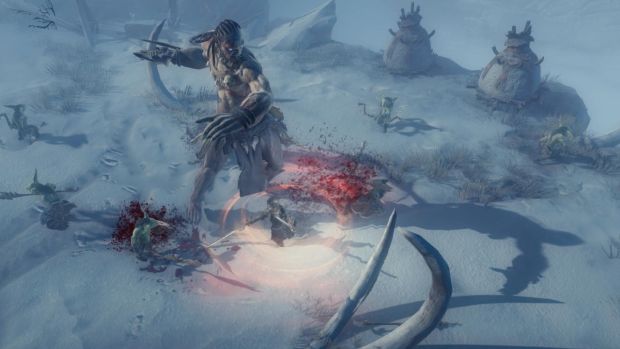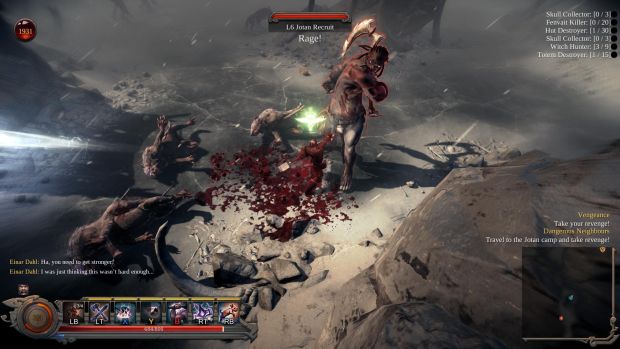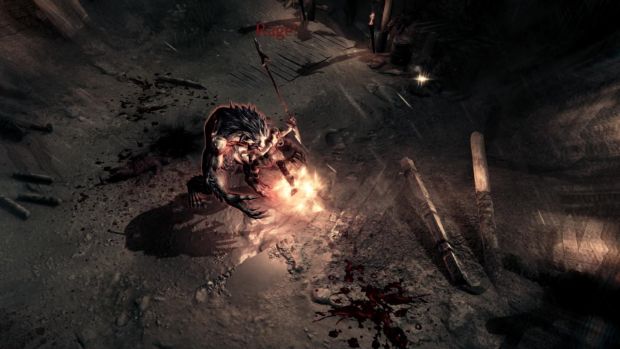
In Vikings: Wolves of Midgard, players take on the mantle of chieftain and lead the Ulfung, a clan of outcast Vikings looked down upon by all other clans. From this most unlikely of beginnings you’ll conquer the other clans, fend of invasion from the nations to the south, and fight to save the nine worlds from impending doom at the hands of the giant Grimnir.
Vikings: Wolves of Midgard saves itself from being a forgettable dungeon crawler by embracing its subject matter whole heartedly, and establishing a core gameplay experience that it then builds gradually as players level up and gain new skills. The first choice you’ll make when you step into Vikings is what characters abilities you want and their chosen style. This means that you start the game with a primary class, but you aren’t locked into it. If you want to multi-spec into an archer as well as your tanking set, you can do so at the cost of progression in your main class. You can even change weapon sets and classes at the press of a button, allowing you to transition through fights in a way that fits the mechanics of the moment.
Player choice is also bolstered by the ability to choose a stat to boost by 1% each time you level up. If you focus on a particular stat, you can work with a 30% increase to damage or health by the time you reach the game’s late stages. Alternatively, you can invest broadly across your stats so that you do everything a little bit better.
"Vikings: Wolves of Midgard saves itself from being a forgettable dungeon crawler by embracing its subject matter whole heartedly, and establishing a core gameplay experience that it then builds gradually as players level up and gain new skills."
Customization and character progression in Vikings are robust enough that they’re engaging, without becoming confusing. Players will fill their skill trees about half way through the campaign, and can then go back through to buff their skills in their main tree or spec into another. This means that players do not have abilities to choose from within their class, each class comes with only as many abilities as it can use, with no spares. This is both a feature and a shortfall. It have been nice to have a little more choice, but in other games with vast arrays of abilities to choose from I typically narrow in on my favorites and use them to the exclusion of all others.
Using the abilities you do have access to is exceptionally satisfying in Vikings. Each ability has a clear use, from engaging enemies in a line, to getting yourself surrounded before freezing them all in a frost nova and then shattering them with a flaming sweep of your sword. Even on lower difficulties, combat in Vikings feels like it has stakes, and while you may be safe taking on a single enemy at a time, tackling groups can be dangerous.
"When it’s not killing you with the environment, Vikings tries to do so with a wide variety of enemies."
The game also rewards risk taking, by granting XP bonuses for multi-kills and forcing you to plow through the levels thanks to the exposure mechanic. Many levels in Vikings take place in hostile environments, be they howling fjords or the poisonous realm of Utgard. The exposure mechanic puts a time limit on how long you can travel through a level, before you have to turn back to the safety of a fire or press on in haste to try and reach the next cave to shelter in. Most of the time, exposure just put a little pressure in the back of my mind as I moved through levels, but it did at times make for truly desperate fights and I tried to cut my way to safety, and I died more than once to the icy cold.
When it’s not killing you with the environment, Vikings tries to do so with a wide variety of enemies. Vikings successfully walks a fragile line between remaining true to the mythology it draws from, and providing players with a rich and diverse encounters and landscapes. Though averting Ragnarok is your primary goal, there are other smaller threats to contend with as well. In order to rebuild your own village you need to subjugate the other clans, and even as giants walk the hillside, crusaders from the south threaten to destroy what remains of your people.
All of these conflicts give players a wide variety of enemies to combat, without feeling like the narrative has lost focus, or that your character is being distracted from the apocalypse just over the horizon. It also means that the game takes place in a variety of landscapes, from frozen tundras to sandy islands and the depths of Hel.
The boss fights at the conclusion of each story mission are just as varied, sometimes taking the form of a single massive enemy, while others are represented by waves of opponents that seek to drown you in their numbers. Each boss fight had its own mechanics and systems to learn, and I almost always needed more than one attempt before I understood the boss well enough to take it down.
"Despite the balance that Vikings brings to player choice and the well-rounded experience that forms the game’s campaign, Vikings is not without its flaws."
Despite the balance that Vikings brings to player choice and the well-rounded experience that forms the game’s campaign, Vikings is not without its flaws. Aspects of the UI are clunky, making the act of selecting a piece of gear or the next ability to unlock a chore that you have to return to again and again. The game also suffers from a repetitive structure. Each raid consists of a zone to fight your way through, populated by enemies that can be dispatched with relative ease, concluded by a boss fight and the distribution of loot before returning to your village. This structure made for a worthwhile first play through, but discourages playing back through the game. Even if you vary your class, or bring a friend along, you’ll be fighting the same things, in the same ways, if you play the game more than once.
The story, while containing an interesting plot, is devoid of characters to sympathize with and feel connected to. The chieftain you play as is an impatient murder machine, who shows no interest in the advice of their counselors, and cares only for when and where they’ll next wet their blade.
Still, bugs hold Vikings back more so than any design flaws. During one boss fight, the boss stood still while I hacked away, while another scripted sequence caused the game to crash three times before I could successfully move on. Hit registration is inconsistent, and enemy health displays can be wildly inaccurate from time to time.
Vikings: Wolves of Midgard is a good game, with great balance in its character customization, and a fun, deep, and rewarding combat system as well as a compelling plot with enough variety of enemies and locations to keep the gameplay fresh across the fifteen hours it takes to complete the campaign. However a repetitive raid structure, and a distracting number of bugs keep the game from being a must buy.
This game was reviewed on the Xbox One.
Vikings delivers an excellent dungeon crawl experience, with diverse classes and abilities, it never feels dull to wade into the next group of enemies, or fines your way through a boss fight.
A predictable structure means there aren’t many surprises to be had, and numerous bugs detract from both the gameplay and functionality of the game.



















